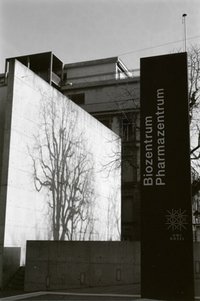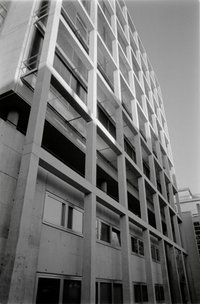The Biozentrum (Center for Molecular Life Sciences) and Pharmazentrum (Department of Pharmaceutical Sciences)
A university history written in 1985 observes that if there is area of Basel in which a university is truly being realized, which is to say, where pioneering scientific work is being done, then it must be at the Biozentrum (Center for Molecular Life Sciences), founded in 1971. In 2000, the Pharmazentrum (Department of Pharmaceutical Sciences) joined the site on Klingelbergstrasse as an extension, strengthening these endeavors.
The Center for Molecular Life Sciences
The overall plan from the Center for Molecular Life Sciences from 1967 envisioned a realization in three stages: first an eight-story building for research and laboratories; then a second a two-story building for teaching; and finally, an additional research building of around nine storeys. The third stage was intended to create space for research in biophysics, genetics, physiological chemistry, and possibly immunology and virology. The approval for the first stage, designed by the architects Burckhardt and Partner, sped through all instances in record time in 1967, with the chemical industry in Basel contributing 5 million Swiss francs to the construction costs of 37.5 million. Basel companies could have increasingly shifted research to their sites abroad instead of helping to finance local research in Basel, but there was an interest in ensuring that enough young talent was being trained at home for research in local parent companies. By the time the first stage was inaugurated in June 1972, the realization of the second and third stages had become a distant prospect – despite the initial hope to realize all three stages by the end of the 1970s.
Initially created as an independent institution, the Center for Molecular Life Sciences was formally integrated into the university in 1974. Being operated as a separate institution under public law, while retaining independence from the state, had brought some advantages during the start-up phase. The decision to integrate the center into the university was made not so much for technical-administrative reasons, but to promote contact with other university members. There was little desire, for instance, to create parallel institutions such as the Max Planck Institutes in Germany. One issue remained to be clarified, however: the relationship to the Faculty of Science, particularly regarding participation in teaching popular, heavily enrolled subjects.
The construction of the building for molecular biologists heightened the aspirations of related disciplines for improved spatial resources. Consequently, a plan was developed in 1980 to construct a new building near the center, aimed at consolidating institutes that had previously been scattered across various locations. The focus first fell on pharmacy, zoology, and mathematics, with botany and geography included later.
In each of these fields, the pressing need for space demanded innovative solutions, with some disciplines facing additional unique challenges. Apart from the space requirements of the individual disciplines, the consolidation of various institutes into a single location was driven by two key factors: first, the efficiency gains from sharing libraries, equipment, lecture halls, and central services; and second, the enhancement of interdisciplinary cooperation that is especially crucial among related fields. The construction of the Biozentrum building, the Rosshof Center, and the then-planned Center for Natural Sciences (now the Pharmazentrum, or Department of Pharmaceutical Sciences), marked a partial reversal of the fragmentation that had resulted in the previous century from increasing specialization in academia, leading to the creation of new departments and physical separations. This trend toward reunification aimed to bring the dispersed teaching and research entities under one roof, as it were, thereby easing and promoting intellectually necessary and often materially beneficial collaboration among different disciplines.
Though the decision did not come immediately, by the twenty-first century the days of the center from 1971 were clearly limited, with a new center finally being opened in 2021 at Spitalstrasse 41 The demolition of the long-unused and vacant Schällemätteli prison commenced swiftly at the end of 2009, to avoid disturbing the nearby children’s hospital scheduled to open in 2010.
The Pharmazentrum (Department of Pharmaceutical Sciences)
The addresses given at the inauguration on 28 October 2000 underscored the significance of the university opening its own new building, as opposed to merely renting a property. A decade later, this significance had taken on a bright yet somewhat nostalgic cast, as the university had failed to add or achieve another architectural work of this caliber. Discussions about creating such a building date back to around 1980. By 1988, two initial designs had been proposed: a circular building by Hotz and a second design – eventually realized – by Roost.
The Pharmazentrum, however, did not establish a new location but rather augmented the existing site that had been developed thirty years earlier with the Center for Molecular Life Sciences on Klingelbergstrasse. One of the notable features of the building, designed with a focus on functionality and adaptability, is its continuous, detached concrete lattice (architect: Andrea Roost). Its purpose mirrors that of the Biozentrum: to serve as a hub for research in the life sciences into the fundamental aspects of biology, engaging pharmacists, biotechnologists, zoologists, and physicians. Additionally, it houses the dean’s office of the Faculty of Science.
Planned in 1991 as the building for the “second” philosophical faculty, reflecting the institutional history of the division between the natural sciences and the humanities, the main purpose of the project was to create a common space for the Department of Pharmacy on Totengässlein (which was threatened with closure in the 1970s and 1980s), and for the IT department together with the computer center. Green-lit in October 1991, the project faced delays in 1993 when the Swiss federal government, preferring to centralize pharmacy studies in Zurich and Lausanne, initially withheld regular support (some 35 percent of the construction costs) from the Basel site. The traditional field of pharmacy, primarily focused on training pharmacists, evolved into Pharmaceutical Sciences. This expansion sought closer ties with adjacent fields such as pharmacology, biology, biotechnology, chemistry, and medicine – the latter being part of the Department of Clinical Biological Sciences (DKBW). And this led to the establishment of the interdisciplinary Pharmazentrum, a forerunner to the later designation of “life” as a research focus area. The Pharmazentrum also houses a large number of the neurobiologists. Before its inauguration, a formal agreement was reached for disciplinary cooperation with ETH Zurich, forging an alliance filled with “great future hopes.” The situation highlighted one key aspect in this elaboration of university spaces: establishing a focus area doesn’t necessarily require physical concentration in the form that had initially been sought by the federal government. In today’s globally connected era, collaboration is feasible even in decentralized structures – in research and in teaching. Lectures are broadcast to various locations, and students can engage with instructors through the interactive “Telepoly” system. The Pharmazentrum thus exemplifies how creating a new building can pave the way for innovative organizational structures in science.




